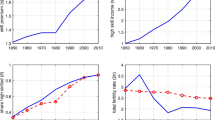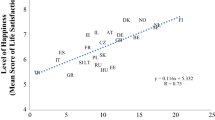Abstract
Vandenbussche et al. (J Econ Growth 11(2):97–127, 2006) and Aghion et al. (in: Romer, Wolfers (eds) Brookings papers on economic activity: conference draft, Brookings, Washington, 2009) show that when economies operate close to the technological frontier, their ability to generate efficiency gains rests on the contribution of workers with advanced forms of education (i.e. tertiary). The contribution of this empirical paper is to revisit and improve the analysis of that assumption, in the context of firms located in advanced economics, assuming that what holds for OECD countries or US states should also be observed also at a more disaggregated level. To that end, we analyse a rich panel of Belgian firm-level data, covering the 2008–14 period. In the first step, we estimate each firm’s proximity to frontier using stochastic frontier methods. Step 2 consists in regressing each firm’s efficiency growth rate on (1) the share of workers by education attainment (2) its (initial) distance/proximity to the frontier and (3) (the main variable of interest) the interaction between (1) and (2), whose sign provides a direct test of the Vandenbussche/Aghion assumption. The main result of the paper supports the idea that the closer the firms are to what amounts to a local frontier; the more educated workers—in particular those with a master’s degree—matter for efficiency gains. The paper also shows that many of them are currently employed in firms that are distant from the efficiency frontier. Reallocating them would have a positive impact on overall efficiency.

Source: Own calculations using Belfirst 2008–2014. The STATA frontier command was use to generate the SF-estimated values for the proximity to frontier

Source: own calculations using Belfirst 2008–2014. The STATA frontier command was use to generate the SF-estimated values for the proximity to frontier

The STATA frontier command was use to generate the SF-estimated values for the proximity to frontier

Similar content being viewed by others
Notes
A natural (inverse) proxy for distance to frontier is “proximity to frontier”.
In the Bartelsman et al. (2015) study, the th quantile return to educated labour corresponds to the marginal change in productivity due to a marginal change in the share of that type of workers conditional on being in a firm belonging to the th quantile of the overall outcome distribution (i.e. the outcome being labour productivity in their case).
The Translog is know for being a flexible functional form for production functions. One of its main advantages is that, unlike the Cobb–Douglas, it does not assume rigid premises such as unitary elasticity of substitution or constant returns to scale. Also Translog functions have been shown to be second-order Taylor approximations of any technology (Fuss et al. 1978; Chambers 1988).
NAICS 2-digit.
That are necessary to implement the Ackerberg et al. (2015) control/proxy econometric estimation aimed at controling for the risk of reverse causality/simultaneity.
NAICS 2 digits.
NAICS 2 digits.
The log of proximity-to-frontier being negative (−∞ ≤ lnPTFit ≤ 0) the positive η's mean that we get smaller contribution to annual efficiency gains when distance to frontier rises (proximity to frontier falls).
The role of education as a net contributor to country-level growth is in fact more disputed than its contribution to individuals' fortune (see Sianesi and van Reenen (2003); de la Fuente and Doménech (2006) for surveys). This is due to the methodological difficulties related to measuring skills and, what is more, modelling and identifying the channels through which skills impact on macroeconomic performance.
The International Standard Classification of Education (ISCED) developped by UNESCO and OECD (for more details see http://uis.unesco.org/sites/default/files/documents/international-standard-classification-of-education-isced-2011-en.pdf.)
And Fig. 4 suggests that larger firms (with more employees) are overrepresented among "frontier" firms (i.e. they form the 6th to 10th decile of the PTF distribution) whereas smaller sizes are predominant among "laggards".
References
Abowd, J. M., Kramarz, F., & Margolis, D. N. (1999). High wage workers and high wage firms. Econometrica, 67(2), 251–334.
Acemoglu, D., Aghion, P., & Zilibotti, F. (2006). Distance to frontier selection, and economic growth. Journal of the European Economic Association, 4, 37–74.
Ackerberg, D. A., & CavesK, Frazer G. (2015). Identification properties of recent production function estimators. Econometrica, 83, 2411–2451.
Aghion, P., Boustan, L., Hoxby, C., & Vandenbussche, J. (2009). The causal impact of education on economic growth: evidence from united states. In D. Romer & J. Wolfers (Eds.), Brookings papers on economic activity: conference draft. Washington, DC: Brookings.
Aghion, P., & Howitt, P. (1992). A model of growth through creative destruction. Econometrica, 60, 323–351.
Aigner, D. J., Lovell, C. A. K., & Schmidt, P. (1977). Formulation and estimation of stochastic frontier production function models. Journal of Econometrics, 6, 21–37.
Andrews, D., Criscuolo, C., & Gal P. (2015). Frontier firms, technology diffusion and public policy: micro evidence from OECD countries. OECD Productivity Working Papers 2.
Barro, R., & Sala-i-Martin, X. (1997). Technological diffusion, convergence and growth. Journal of Economic Growth, 2, 1–26.
Bartelsman, E., Dobbelaere, S., & Peters, B. (2015). Allocation of human capital and innovation at the frontier: firm-level evidence on Germany and the Netherland’s. Industrial and Corporate Change, 24(5), 875–949.
Bartelsman, E. J, Haskel, J., & Ralf M. (2008). Distance to which frontier? Evidence on productivity convergence from international firm-level data. CEPR Discussion Papers 7032
Chambers, R. G. (1988). Applied production analysis: A dual approach. Cambridge: Cambridge University Press.
de la Fuente, A., & Doménech, R. (2006). Human capital in growth regressions: how much difference does data quality make? Journal of the European Economic Association, 4(1), 1–36.
Dumont, M., & Kegels, C. (2016). Young firms and industry dynamics in Belgium. Federal Planning Bureau Working Papers, 1606, Belgium.
Fox, J., & Smeets, V. (2011). Does input quality drive measured differences in firm productivity? International Economic Review, 52(4), 961–989.
Fuss, M., McFadden, D., & Mundlak, Y. (1978). A survey of functional forms in the economic analysis of production. In Production economics: a dual approach to theory and applications, North-Holland, under the direction of Melvin Fuss et Daniel McFadden.
Galindo-Rueda, F., & Haskel J. (2005). Skills, workforce characteristics and firm-level productivity: Evidence from the matched ABI/Employer skills survey. IZA Discussion Paper 1542. IZA: Bonn
Haltiwanger, J., Lane, J., & Spletzer, J. (2007). Wages, productivity, and the dynamic interaction of businesses and workers. Labour Economics, 14(3), 575–602.
Howitt, Peter. (2000). Endogenous growth and cross-country income differences. American Economic Review, 90, 829–846.
Mankiw, G., Romer, D., & Weil, D. (1992). A contribution to the empirics of economic growth. Quarterly Journal of Economics, 107(2), 407–437.
Meeusen, W., & van den Broeck, J. (1977). Productivity estimation from Cobb–Douglas production functions with composed error. International Economic Review, 18, 435–444.
Nelson, R., & Phelps, E. (1966). Investment in humans, technological diffusion, and economic growth. The American Economic Review, 56, 69–75.
Ouimet, P., & Zarutskie, R. (2014). Who works for startups? The relation between firm age, employee age and growth. Journal of Financial Economics, 112, 386–407.
Sianesi, B., & van Reenen, J. (2003). The returns to education: macroeconomics. Journal of Economic Surveys, 17(2), 157–200.
Syverson, C. (2011). What determines productivity? Journal of Economic Literature, 49(2), 326–365.
Turcotte, J., & Rennison, L. W. (2004). The link between technology use, human capital, productivity and wages: firm-level evidence. International Productivity Monitor, 9(Fall), 25–36.
Van Biesebroeck, J. (2011). Wages equal productivity. Fact or fiction? Evidence from SubSaharan Africa. World Development, 39(8), 1333–1346.
Vandenberghe, V., & Lebedinski, L. (2014). Assessing education’s contribution to productivity using firm-level evidence. International Journal of Manpower, 35(8), 1116–1139.
Vandenberghe, V., Rigo, M., & Waltenberg, F. (2013). Ageing and employability. Evidence from belgian firm-level data. Journal of Productivity Analysis, 40(1), 111–136.
Vandenbussche, J., Aghion, P., & Meghir, C. (2006). Distance to frontier, growth, and the composition of human capital. Journal of Economic Growth, 11(2), 97–127.
Author information
Authors and Affiliations
Corresponding author
Appendix: The ACF-GMM Estimator
Appendix: The ACF-GMM Estimator
Considering a stylised version our Stage 2 model Eq. (7),
with
the logic of the ACF-GMM estimator is to consider that the error term comprise εit a time-varying unobserved terms (partially known or anticipated by the management of the firm) ωit that is potentially correlated with the other regressors. It might for instance correspond to a (positive/negative) efficiency development influencing their educational mix.
Key with ACF it to assume that firms’ (observable) demand for intermediate inputs (intit) is a function of ωit as well as labour inputs (here the shares of workers by educational attainement):
ACF further assume that this function ft is monotonic in ωit and its other determinants, meaning that it can be inverted to deliver an expression of ωit as a function of intit, Xit and introduced into the model
The ACF algorithm consists of two steps. In step one, outcome variable (here efficiency growth) is regressed on a composite term Φit that comprises a constant, and 3rd order polynomial expansion in i intit, Xit., approximating \( f_{t}^{ - 1} (int_{it} ,X_{it} ) \)
At that point λ is clearly not identified yet. The first-step regression delivers an unbiased estimate of the composite term Φ hat; it i.e. outcome net of the purely random term σit. This is done at step 2. Key is the idea that one can generate implied values for ωit using first-stage estimates Φ hat it and candidate values for the vector of coefficients λ
ACF assume further that the evolution of ωit follows a first-order Markov process
That assumption simply amounts to saying that the realization of ωit depends on some function g(.) (known by the firm) of t − 1 realisation and an (unknown) innovation term ξit.
By regressing non-parametrically (implied) ωit on (implied) ωit-1, ωit-2, one gets residuals that correspond to the (implied) ξit that can form a sample analogue to the orthogonality (or moment) conditions identifying λ ≡ [α,β,γ1,γ2,γ3,η1,η2,η3,θ].
with the possibility, for some of the variables forming Xit to resort to lagged values, under that assumption that these are less likely to be uncorrelated with the innovation terms ξit. We followed this recommendation for the variables containing education share, meaning that our moment conditions are
Rights and permissions
About this article
Cite this article
Vandenberghe, V. The Contribution of Educated Workers to Firms’ Efficiency Gains: The Key Role of Proximity to the ‘Local’ Frontier. De Economist 166, 259–283 (2018). https://doi.org/10.1007/s10645-018-9322-2
Published:
Issue Date:
DOI: https://doi.org/10.1007/s10645-018-9322-2




